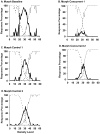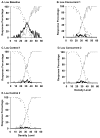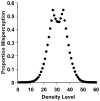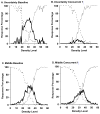Executive-attentional uncertainty responses by rhesus macaques (Macaca mulatta)
- PMID: 22889164
- PMCID: PMC3609932
- DOI: 10.1037/a0029601
Executive-attentional uncertainty responses by rhesus macaques (Macaca mulatta)
Abstract
The uncertainty response has been influential in studies of human perception, and it is crucial in the growing research literature that explores animal metacognition. However, the uncertainty response's interpretation is still sharply debated. The authors sought to clarify this interpretation using the dissociative technique of cognitive loads imposed on ongoing discrimination performance. Four macaques (Macaca mulatta) performed a sparse-dense discrimination within which an uncertainty response let them decline difficult trials or a middle response let them identify middle stimuli. Concurrent memory tasks were occasionally overlain on ongoing discrimination performance. The concurrent tasks disrupted macaques' uncertainty responses far more than their sparse, middle, or dense discrimination responses. This dissociation suggests that the uncertainty response is a higher level decisional response that is particularly dependent on working memory and attentional resources. This is consistent with the theoretical possibility that the uncertainty response is an elemental behavioral index of uncertainty monitoring or metacognition.
PsycINFO Database Record (c) 2013 APA, all rights reserved.
Figures














Similar articles
-
Decision deadlines and uncertainty monitoring: the effect of time constraints on uncertainty and perceptual responses.Psychon Bull Rev. 2014 Jun;21(3):763-70. doi: 10.3758/s13423-013-0521-1. Psychon Bull Rev. 2014. PMID: 24072596 Free PMC article.
-
Rhesus macaques (Macaca mulatta) monitor uncertainty during numerosity judgments.J Exp Psychol Anim Behav Process. 2006 Apr;32(2):111-9. doi: 10.1037/0097-7403.32.2.111. J Exp Psychol Anim Behav Process. 2006. PMID: 16634654
-
Attention, executive functioning and memory in normal aged rhesus monkeys.Behav Brain Res. 2011 May 16;219(1):23-30. doi: 10.1016/j.bbr.2010.12.021. Epub 2010 Dec 17. Behav Brain Res. 2011. PMID: 21168445 Free PMC article.
-
Effects of sleep deprivation on cognition.Prog Brain Res. 2010;185:105-29. doi: 10.1016/B978-0-444-53702-7.00007-5. Prog Brain Res. 2010. PMID: 21075236 Review.
-
Cognitive Pharmacology in Aging Macaques.In: Levin ED, Buccafusco JJ, editors. Animal Models of Cognitive Impairment. Boca Raton (FL): CRC Press/Taylor & Francis; 2006. Chapter 13. In: Levin ED, Buccafusco JJ, editors. Animal Models of Cognitive Impairment. Boca Raton (FL): CRC Press/Taylor & Francis; 2006. Chapter 13. PMID: 21204362 Free Books & Documents. Review.
Cited by
-
Cognitive control of working memory but not familiarity in rhesus monkeys (Macaca mulatta).Learn Behav. 2020 Dec;48(4):444-452. doi: 10.3758/s13420-020-00432-7. Learn Behav. 2020. PMID: 32638291 Free PMC article.
-
Task switching in rhesus macaques (Macaca mulatta) and tufted capuchin monkeys (Cebus apella) during computerized categorization tasks.J Exp Psychol Anim Learn Cogn. 2018 Jul;44(3):229-246. doi: 10.1037/xan0000174. Epub 2018 May 31. J Exp Psychol Anim Learn Cogn. 2018. PMID: 29847983 Free PMC article.
-
The misbehaviour of a metacognitive monkey.Behaviour. 2015;152(6):727-756. doi: 10.1163/1568539X-00003251. Behaviour. 2015. PMID: 26900166 Free PMC article.
-
The transfer of category knowledge by macaques (Macaca mulatta) and humans (Homo sapiens).J Comp Psychol. 2018 Feb;132(1):58-74. doi: 10.1037/com0000095. Epub 2017 Dec 14. J Comp Psychol. 2018. PMID: 29239647 Free PMC article.
-
Rhesus macaques (Macaca mulatta) exhibit the decoy effect in a perceptual discrimination task.Atten Percept Psychophys. 2015 Jul;77(5):1715-25. doi: 10.3758/s13414-015-0885-6. Atten Percept Psychophys. 2015. PMID: 25832189 Free PMC article.
References
-
- Anderson EJ, Mannan SK, Rees G, Sumner P, Kennard C. A role for spatial and nonspatial working memory processes in visual search. Experimental Psychology. 2008;55:301–312. - PubMed
-
- Angell F. On judgments of “like” in discrimination experiments. American Journal of Psychology. 1907;18:253.
-
- Ashby FG, Alfonso-Reese LA, Turken AU, Waldron EM. A neuropsychological theory of multiple systems in category learning. Psychological Review. 1998;105:442–481. - PubMed
-
- Balcomb FK, Gerken L. Three-year-old children can access their own memory to guide responses on a visual matching task. Developmental Science. 2008;11:t750–760. - PubMed
Publication types
MeSH terms
Grants and funding
LinkOut - more resources
Full Text Sources
Other Literature Sources

